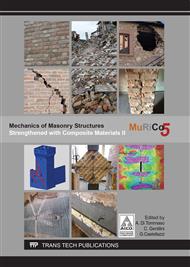p.423
p.431
p.440
p.448
p.456
p.465
p.472
p.480
p.488
Pseudo-Static Response of Masonry Cross Vaults to Imposed Shear Displacements at the Springings
Abstract:
The static and dynamic performances of historical masonry churches are closely related to the behaviour of each substructure, as well as to the mechanical properties of the constituent materials. Information on damage location and extent, collected after recent violent Italian earthquakes, highlighted that masonry vaults are among the most vulnerable elements. The investigation of their dynamic behaviour under earthquake excitation (stress and deformation states) is a fundamental issue for effective structural interventions. During an earthquake ground motion, cross vaults are basically subjected to two phenomena: (i) the "shaking"/dynamic response of the vault system itself, vibrating above the lateral walls and piers, and (ii) the response of the vault to imposed displacements at its springings, accommodating the significant movements of the lateral walls and piers. Within this context, this paper aims at improving the knowledge of the structural behaviour of cross vaults under static shear deformation at the springings, by means of an experimental test representative of a Gothic cross vault from the aisle of the Holyrood Abbey in Edinburgh (UK). The experimental test was performed on a 1:4 scaled specimen built with timber and lime mortar. The shear displacement was applied by moving two abutments until failure. The deformation of the vault was recorded in space with a Total Station. The results of the tests are reported in this paper in terms of crack pattern evolution, vertical displacements of the transverse ridge, identifying the shear displacement levels corresponding to significant damages in the vault.
Info:
Periodical:
Pages:
456-464
Citation:
Online since:
July 2017
Price:
Сopyright:
© 2017 Trans Tech Publications Ltd. All Rights Reserved
Share:
Citation:


